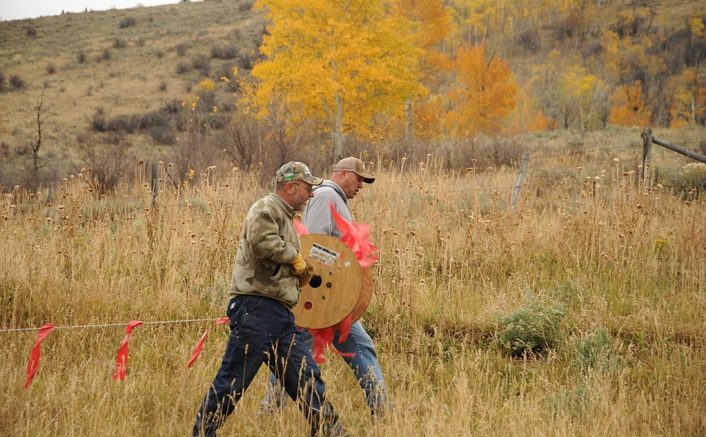MontanaFreePress.org
Wildlife Services, a division of the U.S. Department of Agriculture that annually kills thousands of wild animals across Montana, will at least temporarily cut back on how and where it kills animals such as bears, wolves and coyotes in the state under a settlement reached Thursday with WildEarth Guardians.
The settlement applies to wildlife in protected areas like Wilderness Areas and National Wildlife Refuges, and also halts the use of sodium cyanide bombs on public land and private land in 41 counties until Wildlife Services conducts an updated environmental analysis. The agency will also halt its killing of black bears and mountain lions on federal land within the state.
WildEarth Guardians, an environmental advocacy group with an office in Missoula, sued the USDA’s Animal and Plant Health Inspection Service in federal court in November 2019, arguing that the service must conduct a new environmental analysis, since some of the documents the agency relies on are outdated. Under the agreement, Wildlife Services must conduct an environmental assessment by May 15, 2021. The agency will also pay WildEarth Guardians’ legal fees.
The agreement is part of a WildEarth Guardians campaign across the American West to force Wildlife Services to update the science behind its operations, said Sarah McMillan, the group’s conservation director. The Montana settlement follows similar court decisions in other western states.
“We are pushing for Wildlife Services to get with the program and get up-to-date,” McMillan said.
Predator-livestock conflict is the main reason for most of the wildlife killings conducted by Wildlife Services. In 2018, the most recent year for which data is available, Wildlife Services killed 7,965 coyotes, 46 wolves, one grizzly bear and many other species in Montana.
“The go-to response should not be to go and kill that animal. There are prevention measures that people currently don’t bother taking.”
WILDEARTH GUARDIANS CONSERVATION DIRECTOR SARAH MCMILLAN
The number of grizzly bear-livestock conflicts has skyrocketed in recent years, said John Steuber, state director of Wildlife Services, last year at a meeting with Rep. Greg Gianforte and Secretary of the Interior David Bernhardt. In fiscal year 2019, the agency investigated at least 156 reported incidents of grizzly bear predation in Montana. In 2013, it investigated just 25.
At that meeting, ranchers requested more funding for Wildlife Services to kill grizzlies, which are protected as threatened under the Endangered Species Act.
The Montana Livestock Loss Board pays ranchers for cattle, sheep and other livestock killed by predators. Last year the board paid out $260,838.45 for 373 lost animals. Grizzlies were the predator that caused most of those losses.
In recent years, bears in both the Yellowstone area and the Glacier area have spread out across the landscape and been killed at record rates. The bears have seen significant losses of food sources in both ecosystems due to the warming climate.
Statistics like those provided last year by Steuber are hard to come by, McMillan said. As part of the settlement, Wildlife Services has agreed to post more information online, including the number of requests for assistance, the reasons for those requests, and documentation of any non-lethal preventative measures taken by Wildlife Services or the party seeking assistance.
The settlement also prohibits Wildlife Services from using neck snares to capture black and grizzly bears.
WildEarth Guardians believes the federal government should employ more non-lethal methods to resolve predator-livestock conflicts, especially for iconic and protected species like grizzly bears, McMillan said. Those methods include hazing by bear dogs, installation of deterrent fladry, and range riding.
“[When there is a conflict], the go-to response should not be to go and kill that animal,” she said. “There are prevention measures that people currently don’t bother taking.”
McMillan said increased data availability consequent to the settlement will ideally help prevent preemptive killing, such as aerial gunning. In 2018, 5,300 coyotes, 22 gray wolves and four red foxes were shot from helicopters.
The new restrictions are temporary pending a new environmental assessment to be conducted under the National Environmental Policy Act.TAGGED:Animal and Plant Health Inspection Service, grizzly bears, John Steuber, Montana Livestock Loss Board, National Environmental Policy Act, Predator-livestock conflict, Sarah McMillan, U.S. Department of Agriculture, WildEarth Guardians, Wildlife Services, wolves
 JOHNATHAN HETTINGER
JOHNATHAN HETTINGER
Johnathan Hettinger is a journalist based in Livingston. Originally from Central Illinois and a graduate of the University of Illinois, he has worked at the Midwest Center for Investigative Reporting, the Livingston Enterprise and the (Champaign-Urbana) News-Gazette. Contact Johnathan at [email protected] and follow him on Twitter.More by Johnathan Hettinger

Be the first to comment on "Wildlife Services to cut back killings pending environmental review"